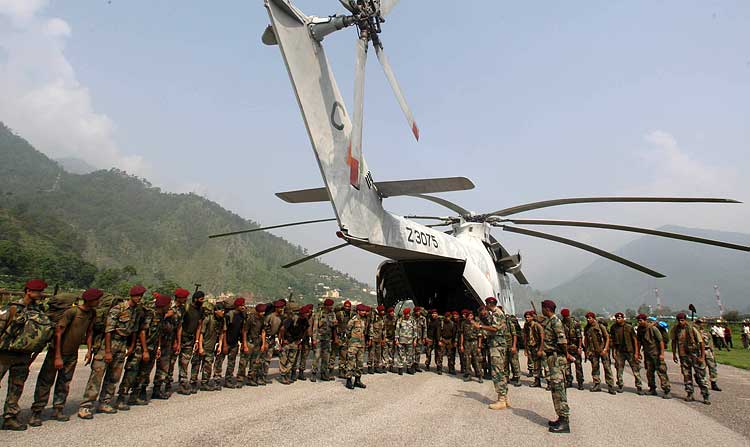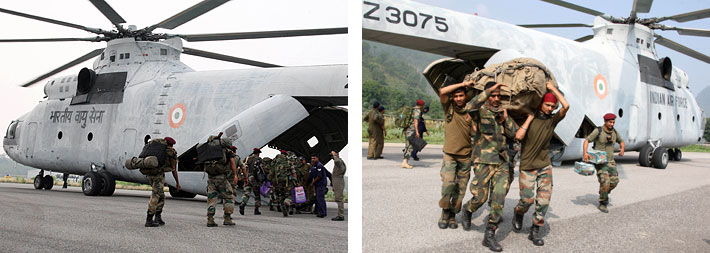INDIAN ARMED FORCES CHIEFS ON OUR RELENTLESS AND FOCUSED PUBLISHING EFFORTS

The insightful articles, inspiring narrations and analytical perspectives presented by the Editorial Team, establish an alluring connect with the reader. My compliments and best wishes to SP Guide Publications.

"Over the past 60 years, the growth of SP Guide Publications has mirrored the rising stature of Indian Navy. Its well-researched and informative magazines on Defence and Aerospace sector have served to shape an educated opinion of our military personnel, policy makers and the public alike. I wish SP's Publication team continued success, fair winds and following seas in all future endeavour!"

Since, its inception in 1964, SP Guide Publications has consistently demonstrated commitment to high-quality journalism in the aerospace and defence sectors, earning a well-deserved reputation as Asia's largest media house in this domain. I wish SP Guide Publications continued success in its pursuit of excellence.
- Operation Sindoor: Resolute yet Restrained
- India’s Operation Sindoor Sends a Clear Message to Terror and the World – ‘ZERO TOLERANCE’
- Japan and India set forth a defence cooperation consultancy framework, talks on tank and jet engines
- Terrorist Attack in Pahalgam in Kashmir: Unfolding a long surgical war against PAK
- Lt General Pratik Sharma takes over Command of Indian Army's Northern Command
Boosting IAF's Heavy Lift Capability
India's strategic overhaul of Mi-26 Helicopters enhances IAF's heavy-lift capabilities and paves the way for unmatched heavy-lift synergy with Chinooks
 |
The Author is Former Director General of Information Systems and A Special Forces Veteran, Indian Army |

The Mi-26 is the largest helicopter in the world designed to carry outsized cargo to remote destinations that are unreachable by other aircraft. Its characteristics include: crew of five including two pilots; capacity 90 troops or 60 stretchers, 20,000 kg cargo; length 40.025 m (131 ft 4 in); height 8.145 m (26 ft 9 in); empty weight 28,200 kg; gross weight 49,600 kg; max takeoff weight 56,000 kg; fuel capacity 12,000 litre; power plant two ZKMB Progress D-136 turbo-shaft engines, 8,500 kW (11,400 hp) each; main rotor diameter 32 m (105 ft 0 in); main rotor area 804.25 m² (8,656.9 sq ft); blade section root TsAGI 12 per cent, tip TsAGI 9 per cent. Performance parameters of the Mi-26 are: maximum speed 295 km/h (183 mph); cruise speed 255 km/h (158 mph); range 500 km with 7,700 kg cargo; ferry range 1,920 km with auxiliary tanks; service ceiling 4,600 m (15,100 ft).
The Mi-26, with its unique heavy-lift capability, has been a critical force multiplier for the IAF for over three decades
The IAF utilised the Mi-26 helicopter, possessing unique heavy-lift capability, for over three decades. The helicopter’s heavy-lift capabilities were tested during the airlift of odd-sized and heavy equipment for the Katra-Quazigund railway project as part of extending rail connectivity in the Srinagar Valley around 2010. In addition, it was also extensively utilised for airlift during Operation ‘Rahat’ in 2013. One of the duties the helicopter performed was the airlift of 9,000 litres of aviation turbine fuel (ATF) to Pithoragarh Advanced Landing Ground (ALG) to keep the Humanitarian Assistance and Disaster Relief (HADR) going.

An IAF source told media, “These (Mi-26) helicopters are very capable in terms of both internal and external load carrying capability and thus serves a critical role in airlift of heavier and voluminous loads. The Mi-26 can airlift a maximum of 20 tonnes of load and around 8-10 tonnes at high-altitudes, depending on the prevailing conditions.” Another IAF source said, “The Mi-26 has proven its worth under most adverse operating conditions, for example, at Daulat Beg Oldi (DBO), which lies at the northern edge of Depsang Plains at an elevation of 5,100 m (16,700 ft), it can carry over 5,000 kg of load. Most other helicopters in the IAF inventory can carry a minuscule payload at this elevation. This uniqueness of the Mi-26 helicopter makes it a true force multiplier.”
The IAF fleet of 3 x Mi-26 helicopters is set to undergo a comprehensive overhaul, extending their operational life by more than a decade
The good news now is that the IAF fleet of 3 x Mi-26 helicopters is set to be overhauled following a contract signed by the IAF with Russian Helicopters, a subsidiary of Russian industry giant Rostec. The entire process of repair and overhaul will require 30 months from the date of commencement of the overhaul. The overhaul process will involve firming up the airframe’s integrity and fatigue if needed, particularly the load bearing areas, and involve replacing the major components that have completed their lives. In addition, the helicopter engines will be overhauled to give them a fresh lease of life and parts like the turbine blades or the seals replaced with fresh ones. The avionics components will also be checked to see if any part needs to be replaced and indigenous systems will be integrated.
Notably, the overhaul of these three Mi-26 helicopters, which was earlier planned to be done in Russia, are much larger in capabilities compared to the Chinooks, will now be done locally in India with the help from the Russian defence firm. The planned overhaul will extend the life of these Mi-26 helicopters by more than a decade. Work is set to begin soon and India will become the first country to have a simultaneous inventory of both Russian Mi-26 and the American Chinook helicopters.
The overhaul process, previously planned in Russia, will now be done locally in India, making India the first country to simultaneously operate both Mi-26 and Chinook helicopters
The IAF has 15 Chinook helicopters based at Chandigarh and Assam to meet the operational requirements primarily of the north and the northeast India. Characteristics of Chinook helicopter include: crew of three; capacity 33–55 troops or 24 stretchers and 3 attendants or 24,000 lb (10,886 kg) payload; length 98 ft (30 m); fuselage length 52 ft (16 m); width 12 ft 5 in (3.78 m) (fuselage); height 18 ft 11 in (5.77 m); empty weight 24,578 lb (11,148 kg); maximum takeoff weight 50,000 lb (22,680 kg); power-plant 2 x Lycoming T55-GA-714A turbo-shaft engines, 4,733 shp (3,529 kW) each; main rotor diameter 2×60 ft (18 m); main rotor area 5,600 sq ft (520 m²).

Performance parameters of the Chinook helicopter are: maximum speed 196 mph (315 km/h); cruise speed 184 mph (296 km/h); range 740 km; combat range 370 km; ferry range 2,252 km; service ceiling 20,000 ft; rate of climb 1,522 ft/min (7.73 m/s). The Chinook helicopter is armed with three pintle-mounted machine guns – one on the loading ramps and two on the shoulder windows.
The synergy of the overhauled Mi-26 fleet, along with the existing inventory of 15 Chinook helicopters, positions the IAF for unparalleled heavy-lift capabilities, crucial for humanitarian aid, disaster relief, and mass casualty evacuation
Making the three Mi-26 helicopters serviceable with extended life of a decade plus,coupled with the 15 Chinook helicopters on its inventory, will boost the heavy lift capabilities of the IAF enormously. Notably, with the maximum takeoff weight of 56,000 kg, the Mi-26 helicopter can even airlift a Chinook helicopter. Moreover, the Mi-26 and Chinook can seat 82 and 45 combat ready troops respectively. The Mi-26 is invaluable for HADR and in coping with mass casualty evacuation, in that, one single Mi-25 helicopter can evacuate 60 casualties along with medical attendants.





